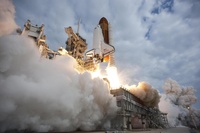Eileen Collins
American - (NASA)
Retired
Date of Birth: Nov. 19, 1956
Age: 67
Eileen Marie Collins is a retired NASA astronaut and a retired United States Air Force colonel. A former military instructor and test pilot, Collins was the first female pilot and first female commander of a Space Shuttle. She was awarded several medals for her work. Colonel Collins has logged 38 days 8 hours and 20 minutes in outer space. Collins retired on May 1, 2006, to pursue private interests, including service as a board member of USAA.
Space Shuttle Discovery / OV-103 | STS-63
National Aeronautics and Space Administration | United States of AmericaKennedy Space Center, FL, USA
Feb. 3, 1995, 5:22 a.m.
Status: Success
Mission:
STS-63 was the first mission of the US/Russian Shuttle-Mir Program, which carried out the first rendezvous of the American Space Shuttle with Russia's space station Mir. Known as the 'Near-Mir' mission, the flight used Space Shuttle Discovery, which lifted off from launch pad 39B on 3 February 1995 from Kennedy Space Center, Florida.
Low Earth OrbitSpace Shuttle Columbia / OV-102 | STS-84
National Aeronautics and Space Administration | United States of AmericaKennedy Space Center, FL, USA
May 15, 1997, 8:07 a.m.
Space Shuttle Columbia OV-102 | STS-93
National Aeronautics and Space Administration | United States of AmericaKennedy Space Center, FL, USA
July 23, 1999, 4:31 a.m.
Status: Success
Mission:
STS-93 marked the 95th launch of the Space Shuttle, the 26th launch of Columbia, and the 21st night launch of a Space Shuttle. Eileen Collins became the first female shuttle Commander on this flight. Its primary payload was the Chandra X-ray Observatory.
Low Earth OrbitSpace Shuttle Discovery / OV-103 | STS-114
National Aeronautics and Space Administration | United States of AmericaKennedy Space Center, FL, USA
July 26, 2005, 2:39 p.m.
Status: Success
Mission:
STS-114 was the first "Return to Flight" Space Shuttle mission following the Space Shuttle Columbia disaster. Discovery launched at 10:39 EDT (14:39 UTC), 26 July 2005. The launch, 907 days (approx. 29 months) after the loss of Columbia, was approved despite unresolved fuel sensor anomalies in the external tank that had prevented the shuttle from launching on 13 July, its originally scheduled date.
Low Earth OrbitThe National Aeronautics and Space Administration is an independent agency of the executive branch of the United States federal government responsible for the civilian space program, as well as aeronautics and aerospace research. NASA have many launch facilities but most are inactive. The most commonly used pad will be LC-39B at Kennedy Space Center in Florida.
Falcon 9
Starlink Group 9-3
Space Launch Complex 4E - Vandenberg SFB, CA, USAA batch of 20 satellites for the Starlink mega-constellation - SpaceX's project for space-based Internet communication system.
Hyperbola-1
Yunyao-1 15-17
Launch Area 95A - Jiuquan Satellite Launch Center, People's Republic of China3 weather satellites performing atmospheric measurements using GNSS Radio Occultation for a Tianjin based company. Constellation is planned to have a…
Ariane 62
Maiden Flight
Ariane Launch Area 4 - Guiana Space Centre, French GuianaMaiden Flight of the Ariane 62 launch vehicle, carrying ten cubesats, two deployers, five experiments, and two reentry capsules.
Falcon 9
Türksat 6A
Space Launch Complex 40 - Cape Canaveral, FL, USATürksat 6A is Turkey's first domestically manufactured geostationary communications satellite. It is to reside in 42° East orbital slot, providing se…
Long March 6A
Tianhui 5 Group 02
Launch Complex 9A - Taiyuan Satellite Launch Center, People's Republic of ChinaA pair of satellites officially described as for cartographic surveying purposes, details TBD.



